In the
beginning
The story begins in 1987, when the Government commissioned a study to examine the
feasibility of a 5th terrestrial television channel in the UK. The
investigation was carried out by the Department for Trade and Industry, The Independent Broadcasting Authority (IBA) and the BBC. The main
arguments put forward by the study in favour of a fifth TV channel were to give viewers more choice at no extra cost and to increase competition
amongst commercial TV broadcasters and reduce the cost of advertising. Studies established that coverage of 65-70% of the population could be provided on Ultra High Frequency (UHF) in the band using channels 35 and 37. Both channels were in use at the time for non-broadcasting purposes, but these users would be moved to other frequencies. It was also pointed out that in some areas it may be
necessary to retune video recorders and other domestic equipment to avoid
interference from the Channel 5 signal.
In 1990 The Broadcasting Act was passed which stated in Section 28, that The
Independent Television Commission was required to establish a fifth terrestrial TV channel and Section 29 stated that they must award the licence through competitive tender. The
commission had to be satisfied that the applicants passed a programme quality threshold, The programmes to be included in the service must be of high quality and appeal to a wide variety of tastes and interests. It was also required that in addition, all
applicants must submit a cash bid and business plan. Section 30 of the act also stated that retuning of equipment must take place at the
expense of the licensee. The invitation to apply for the Channel 5 licence was issued by the ITC on 14th April 1992. One one
application, by 'Channel Five Holdings Ltd' on 7th July 1992. In December 1992 the bid by Channel 5 Holdings Ltd was rejected after the ITC expressed doubts over the business plan and level of investor commitment.
In July 1993 the ITC published a consultation document incorporating the results of of an ITC technical review. More than 70
responses had been received by October, including declarations of interest from parties who may be
interested in applying, should the licence for Channel 5 be readvertised. The ITC decided in February 1994 that there was a strong case for the readvertising of the licence, all that was needed was confirmation from the Government that the
original frequencies were still available. The Secretary of State for National Heritage,
announced on 14th July, the Governments decision that one of the two original frequencies, Channel 35, would not be available for the purpose of broadcasting a 5th
terrestrial channel. The ITC expressed concern over the matter, but still managed to clear transmitter sites to gain a possibly more than 60% coverage for the Channel 5 signal.
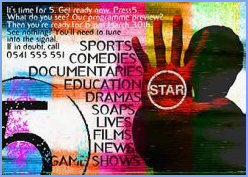 The
decision to readvertise the Channel 5 licence was announced on
15th Septem
ber 1994, with the invitation to apply issued on 1st
November 1994. The closing date for applying was set as 2nd May 1995.
Applicants had to show they had a detailed plan with the resources to back it, to show that they had the capability to retune all domestic equipment which would suffer
interference from the Channel 5 signal. The ITC stated that a minimum starting area with full coverage (66% of the population) was to be achieved as quickly as possible and no later than year 5 of the 10 year licence. The ITC set a minimum
amount of time for each of the mandatory programme categories which the
licencece would be expected to satisfy, with an increased minimum in the sixth year. The first part of the tender was set by the ITC at zero. The
decision to readvertise the Channel 5 licence was announced on
15th Septem
ber 1994, with the invitation to apply issued on 1st
November 1994. The closing date for applying was set as 2nd May 1995.
Applicants had to show they had a detailed plan with the resources to back it, to show that they had the capability to retune all domestic equipment which would suffer
interference from the Channel 5 signal. The ITC stated that a minimum starting area with full coverage (66% of the population) was to be achieved as quickly as possible and no later than year 5 of the 10 year licence. The ITC set a minimum
amount of time for each of the mandatory programme categories which the
licencece would be expected to satisfy, with an increased minimum in the sixth year. The first part of the tender was set by the ITC at zero.
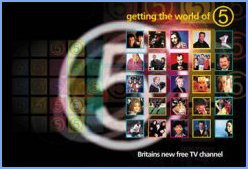 On 2nd May 1995,
the ITC received four applications for the Channel 5 licence.
The bids came from New Century TV Ltd (British Sky
Broadcasting, Goldman Sachs, Granada Group, Hoare Govett,
Kinnevik, Polygram, Really Useful Group and TCI International)
who bid £2,000,000; Virgin TV Ltd with a bid of £22,002,000;
UKTV (CanWest Global Communications Corp., Scandinavian
Broadcast System SA, SelectTV Plc, The Ten Group Ltd) who bid
£36,261,158 and Channel 5 Broadcasting Ltd (MAI (now United
News and Media Plc), CLT/UFA, Pearson Plc, Warburg Pincus
& Co) with a bid of £22,002,000. The ITC sought and
recived undertakings in relation to the two identical bids
from Virgin Television Ltd and Channel 5 Broadcasting
Ltd. On 2nd May 1995,
the ITC received four applications for the Channel 5 licence.
The bids came from New Century TV Ltd (British Sky
Broadcasting, Goldman Sachs, Granada Group, Hoare Govett,
Kinnevik, Polygram, Really Useful Group and TCI International)
who bid £2,000,000; Virgin TV Ltd with a bid of £22,002,000;
UKTV (CanWest Global Communications Corp., Scandinavian
Broadcast System SA, SelectTV Plc, The Ten Group Ltd) who bid
£36,261,158 and Channel 5 Broadcasting Ltd (MAI (now United
News and Media Plc), CLT/UFA, Pearson Plc, Warburg Pincus
& Co) with a bid of £22,002,000. The ITC sought and
recived undertakings in relation to the two identical bids
from Virgin Television Ltd and Channel 5 Broadcasting
Ltd. 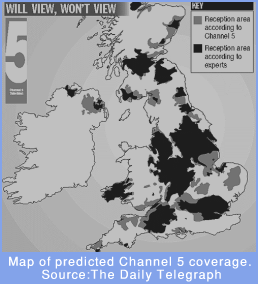 Comments
from the ITC's Viewer Consultive Councils (VCCs) and viewers,
who were invited to comment by the ITC leaflet 'New Channel 5
licence - your chance to comment', were taken into account by the
Commission. Channel 5 Broadcasting Ltd and New Century
Television both passed the quality threshold requirement in
relation to programming. UKTV and Virgin TV both did not meet
the requirement for different reasons. It was announced on
27th October 1995 that the bid with the highest cash bid of
the two that met the threshold, Channel 5 Broadcasting Ltd was
to be granted the licence. Virgin TV however, appealed against
the ITC's decision and on 22nd November 1995 the High Court
granted leave for a judicial review of the decision.
On 26th January 1996 the judgement was
issued. The review found that there was no indication of
illegality or unfairness in the ITC's award of the licence and
no evidence that Channel 5 Broadcasting had been treated
preferentially. Comments
from the ITC's Viewer Consultive Councils (VCCs) and viewers,
who were invited to comment by the ITC leaflet 'New Channel 5
licence - your chance to comment', were taken into account by the
Commission. Channel 5 Broadcasting Ltd and New Century
Television both passed the quality threshold requirement in
relation to programming. UKTV and Virgin TV both did not meet
the requirement for different reasons. It was announced on
27th October 1995 that the bid with the highest cash bid of
the two that met the threshold, Channel 5 Broadcasting Ltd was
to be granted the licence. Virgin TV however, appealed against
the ITC's decision and on 22nd November 1995 the High Court
granted leave for a judicial review of the decision.
On 26th January 1996 the judgement was
issued. The review found that there was no indication of
illegality or unfairness in the ITC's award of the licence and
no evidence that Channel 5 Broadcasting had been treated
preferentially.
On 18th April
1996 the ITC confirmed the granting of the licence to Channel
5 Broadcasting Ltd. The licence agreement states that 50% of
programming must be original productions and commissions and
there are also requirements for the number of hours of
religion, children's, news and current affairs. 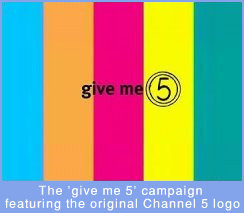 David Elstein, after
recent experience at BSkyB became the chief executive in
August 1996, Dawn Airey from Channel 4 became director of
programmes, Michael Atwell became controller of features and
arts, Tim Gardam was controller of current affairs and
documentaries. David Elstein, after
recent experience at BSkyB became the chief executive in
August 1996, Dawn Airey from Channel 4 became director of
programmes, Michael Atwell became controller of features and
arts, Tim Gardam was controller of current affairs and
documentaries.
Before broadcasting could begin, Channel
5 had to retune video, cable and satellite equipment in over 9
million homes across the UK, to comply with the ITC Code of
Practice on Equipment Retuning, which stated that they needed
to retune 90% of homes affected before the service could
start. This was to be the largest house-to-house operation
since the conversion to natural gas. Channel 5 used the
retuning programme to establish their identity and brand
months before the channel came to TV screens with it's 'give
me 5' campaign. In September 1996, the Department of Tradeand Industry allocated Channel 35 for use
by Channel 5 for an inital period of 5 years.
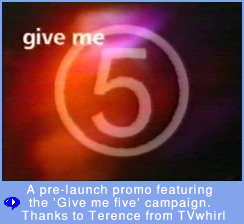 Wolff Olins created an image awareness campaign for the channel's re-tuning identity, under
the banner 'Give me 5'. The Channel 5 image and brand were
applied in poster and print advertising, re-tuning mailings,
vehicles and staff clothing. For the re-tuning a video was
also produced for the re-tuners to run while working, a
promotional piece for use in Blockbuster Video stores and
commercial sponsors. Wolff Olins created an image awareness campaign for the channel's re-tuning identity, under
the banner 'Give me 5'. The Channel 5 image and brand were
applied in poster and print advertising, re-tuning mailings,
vehicles and staff clothing. For the re-tuning a video was
also produced for the re-tuners to run while working, a
promotional piece for use in Blockbuster Video stores and
commercial sponsors.
The retuning
campaign achieved 92% unprompted awareness in under three
months. The campaign was so successful that Channel 5 decided
to use the same identity for its onscreen branding.
The launch
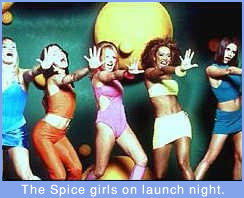 On the 30th March 1997 at 6:00p.m.
Channel 5 launched by the Spice Girls (when there were 5
members) and introduced by Tim Vine and Julia Bradbury. 5 news
revolutionised the way News was presented on television when
Kirsty Young presented from the newsroom perched on the front
of the desk (instead of sat behind a desk as was usual). The
channel also became the only terrestrial channel with a 'DOG',
a small channel identifier in the top left hand corner of the
screen. The intensity of the dog was toned down after
complaints from
viewers. On the 30th March 1997 at 6:00p.m.
Channel 5 launched by the Spice Girls (when there were 5
members) and introduced by Tim Vine and Julia Bradbury. 5 news
revolutionised the way News was presented on television when
Kirsty Young presented from the newsroom perched on the front
of the desk (instead of sat behind a desk as was usual). The
channel also became the only terrestrial channel with a 'DOG',
a small channel identifier in the top left hand corner of the
screen. The intensity of the dog was toned down after
complaints from
viewers.
The first set of idents were 'live action' with the main colours used being the 5 colours of the 'five bar', Blue, Orange, Magenta, Yellow and Green. Some featured people, a spinning '5' logo, others mixed shots of things with the 'five' colours in, like pink rose petals. Channel 5 also were the first terrestrial channel to introduce film ratings. 'U' for Universal, 'G' for
Guidance, 'C' for caution and 'A' for Adult. These would be shown after the ident.
Another new look?
After just two and a half years channel 5 revamped the channel with new idents. These second batch of idents, a very white set introduced in 1999, featured personalities including news presenters Kirsty Young and Rob Bultler, cook Kieth Floyd, DJ 'Dr Fox' and presenter Gloria Huniford who spoke via
speech bubbles, with the exception of one featuring a naked Keith Chegwin. These were the first idents to feature the 'five bar'. The idents were
supposed to "make fun of the channel'.
In November 1999, Kirsty Young left 5 after a bidding war between Channel 5 and ITV. Kirsty went to co-present the ITV lunchtime news with John Suchet after agreeing to a two-year deal worth £500,000.
In early 2000 Andrea Catherwood, from ITV News, joined the channel as the new face of 5news, replacing Kirsty Young. Her debut on 24th January saw a new 'white' look for 5 news. While the 'perching' newsreaders remain, the programmes now come from a set, sectioned off from the old newsroom setting.
The new-look studio was designed to inject the station with a more "grown-up" and "subtle" feel. Chris Shaw, controller of news, said the revamped studio reflected the channel's commitment to presenting "clean" and "clear" news.
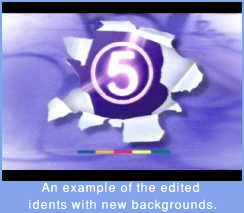 Yet again the
channel identity was refreshed after a year, introduced in
2000, the idents were similar in style to the previous set but
this time the personalities were not necessarily presenters or
personalities from the channel. The white now had a hint of
one of the 'five bar' colours. In May 2000, the licence for
the Channel 5 text was awarded to Teletext Ltd and is valid
for 10 years from 1 July 2002. The 'personality' versions were
discontinued in mid-2001 and a set of edited short versions
with animated dark backgrounds were introduced in September
2001. Yet again the
channel identity was refreshed after a year, introduced in
2000, the idents were similar in style to the previous set but
this time the personalities were not necessarily presenters or
personalities from the channel. The white now had a hint of
one of the 'five bar' colours. In May 2000, the licence for
the Channel 5 text was awarded to Teletext Ltd and is valid
for 10 years from 1 July 2002. The 'personality' versions were
discontinued in mid-2001 and a set of edited short versions
with animated dark backgrounds were introduced in September
2001.
In October 2001,
Channel 5 announced the return of Kirsty Young to the channel.
She has accepted a £500,000-a-year deal to leave ITV and
rejoin the Channels news team after two years away. This come
shortly after she anchored five hours of running news after
the attack on the World Trade Centre on September 11th. While
at ITV she had also presented a science show, How Do They Do
That?, a quiz show, The People Versus, and she presented a
pilot of the crime show Rat Trap.
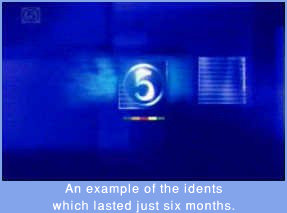 The shortest lived idents, lasting
only six months followed shortly after. A new identity to
"refresh" the channel was announced in early 2002 and on
Monday 4th March 2002 a new ident, supposed to give the
channel a "sophisticated" look, was launched. Almost
immediately after, it was announced that channel 5 were to
relaunch in September of that year. Shortly before the
relaunch Channel 5 were awarded the first ever "Channel of the
Year award 2002" at the Edinburgh Television
festival. The shortest lived idents, lasting
only six months followed shortly after. A new identity to
"refresh" the channel was announced in early 2002 and on
Monday 4th March 2002 a new ident, supposed to give the
channel a "sophisticated" look, was launched. Almost
immediately after, it was announced that channel 5 were to
relaunch in September of that year. Shortly before the
relaunch Channel 5 were awarded the first ever "Channel of the
Year award 2002" at the Edinburgh Television
festival.
From 'Channel 5' to 'five'
Yet
again the channel identity was refreshed after a year,
introduced in 2000, the idents were similar in style to the
previous set but this time the personalities were not
necessarily presenters or personalities from the channel. The
white now had a hint of one of the 'five bar' colours. In May
2000, the licence for the Channel 5 text was awarded to
Teletext Ltd and is valid for 10 years from 1 July 2002. The
'personality' versions were discontinued in mid-2001 and a set
of edited short versions with animated dark backgrounds were
introduced in September 2001.
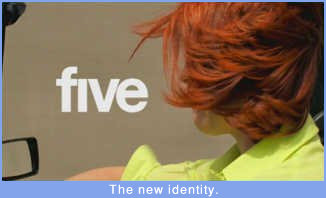 The new 'five was developed by creative strategists WalkerBannisterBuss; design agency Spin and advertising company TBWA\London
WalkerBannisterBuss worked closely with Five's creative strategy team in Programming and Marketing to help identify and articulate the channel's positioning moving forward.
The new 'five was developed by creative strategists WalkerBannisterBuss; design agency Spin and advertising company TBWA\London
WalkerBannisterBuss worked closely with Five's creative strategy team in Programming and Marketing to help identify and articulate the channel's positioning moving forward.
WBB helped to distil key themes from existing and new research, and to formulate potential positioning for the channel, before working with the team to identify the channel's core values and organising thought.
The Spin team of Creative Director, Warren Beeby, Group Account Director Martin Saunders and Senior Designer, Chris Turner, worked with Five's in-house Creative Services department to create an entirely fresh on-air look comprising an integrated graphics system and a new logo, plus personality-defining live-action idents.
The channel's logo, previously the number 5 within a circle supported by the colour bar, will now be replaced by Five, which will always appear in lower case. The original 'five bar' colours have now been expanded to five distinct palettes, each comprising five colours. The channel will also use "purely typographical promos - which will see copy-written type overlaid over sound bites from the channel's key shows".
The new look also saw the disappearance of the 'DOG', as according to 'five' it was no longer needed.
At the end of 2002, Five secured new transmission frequencies to broadcast to the 50 per cent of homes in the affluent South East that its patchy coverage has missed. The company was given clearance to use four transmission masts in the region, with a further four are understood to be close to agreement, bringing Five into a further 1.1m South East homes out of a total of 2.2m households.
Five signed up to a new 10-year licence
with the Independent Television Commission on 13th March
2003.Instead of the annual cash sum of £24.6m which Five paid
under the old deal, it will now pay around £4.4m a year, but
under the new licence, which takes effect from, Five will also
pay 8% of "qualifying revenue", made up mainly of sponsorship
and advertising. This was meant to make the licence more
responsive to the vicissitudes of the advertising
market.
|